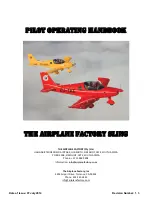
GDMUBI15-1G
Version 0030
17
and low cruise speed adjustment, it may be necessary to increase the speed before the
wing is put into banking to avoid stalling the lower wing. An increase in engine power is
also advised to maintain the flight level during the turn.
S
talling:
The stalling point is reached more easily with a backward hang point position. Once the
stall angle of attack is reached, the control bar starts pushing back forcefully and some
pre-stall buffet may be felt in the form of pressure bumps. Avoiding any resistance to this
tendency for a short while allows the wing to return to correct speed. In that case, the loss
of altitude will be less than 10 m. (33 ft) If the control bar remains extended despite the
warning signs, the wing will stall and the loss of altitude may easily reach 30 m (100 ft).
An asymmetrical start
on one wing is possible,
particularly during the running in of the
sail (first 50 flying hours).
Nose high pitch attitudes generated prior to the stall break will lead to high nose down
rotation rates. In common with all flexwing aircraft, extreme examples of this can result
in tumbling motions, loss of control and massive structural failure.
To avoid risk of tumbling, stalling exercises must imperatively be carried out with the
engine at idle, with a very slow decrease in speed (less than 1kt/sec) obtained by
progressively pushing the control bar out.
Pilots should also be aware that as with all aircraft, overloading with baggage/heavy
occupants will increase stalling speed, as well as the usual drawbacks of reduced
performance, maneuverability and structural safety margins.
Behavior in strong wind:
Once grounded and motionless
Park the aircraft perpendicular to the direction of the wind, with its windward wing
lowered and the tip of the leading edge rests on the ground (the wing tip fins are mounted
flexibly to allow the tip of the leading edge take the pressure if the wind is strong), block
the A frame on the front tube of the trike (using for example the Velcro used for packing
the battens of the sail), block the park brake and put chocks under all three wheels. Take
the wing off the trike and put it flat on the ground windward, if the aircraft is not going to
be used immediately.
Ground-runs
Keep the sail flat into a headwind. Push the control bar against the trike front strut with a
tailwind. This will avoid flipping. With a side wind, be careful to always tilt the wing so
that the windward edge is slightly lower than the rest of the wing.. It may be difficult to
hold the A-frame in its position. Never let the wind lift the wing up.
Take-off and landing
As ground run distances are considerably reduced by strong wind, try to face the wind.
Perform take-off and landing maneuvers at greater speed than you would normally do, in
order to diminish the drift angle and counter the effects of the gradient.






































